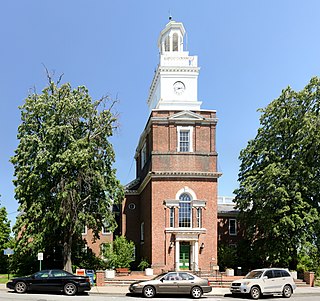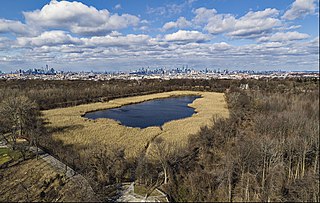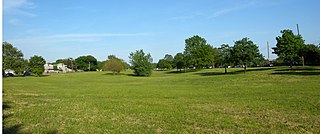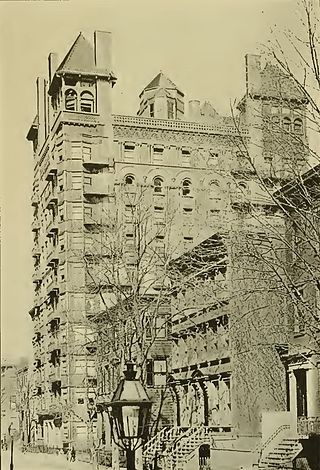
Freeport is a village in the town of Hempstead, in Nassau County, on the South Shore of Long Island, in New York state. The population was 43,713 at the 2010 census, making it the second largest village in New York by population.

Papplewick Pumping Station, situated in open agricultural land approximately 3 miles (4.8 km) by road from the Nottinghamshire village of Papplewick, was built by Nottingham Corporation Water Department between 1881 and 1884 to pump water from the Bunter sandstone to provide drinking water to the City of Nottingham, in England. Two beam engines, supplied with steam by six Lancashire boilers, were housed in Gothic Revival buildings. Apart from changes to the boiler grates, the equipment remained in its original form until the station was decommissioned in 1969, when it was replaced by four submersible electric pumps.

Mount Crosby pumping station is a heritage-listed pumping station and weir at Stumers Road, Mount Crosby, City of Brisbane, Queensland, Australia. It is located on the Brisbane River and extends into Chuwar on the other side of the river. The facility supplies water to Brisbane and nearby cities and towns within the SEQ Water Grid. It was originally designed by Charles H McLay and built from 1891 to 1892. The historic parts of the facility were added to the Queensland Heritage Register on 25 October 2019. It is also listed on the Brisbane Heritage Register, together with numerous associated facilities which were not included in the state heritage listing.

Ridgewood Reservoir is a decommissioned 19th century reservoir and freshwater wetland on the border between the New York City boroughs of Brooklyn and Queens, within what is now Highland Park. Although the reservoir was originally built to secure a reliable water supply for the City of Brooklyn, it is positioned on the Queens side of the border in the neighborhood of Glendale. The reservoir and park are bounded on the north by the Jackie Robinson Parkway, on the south by Highland Boulevard, on the west by Vermont Place and on the east by Cypress Hills National Cemetery.

The Eden Park Station No. 7 is a historic structure located in Eden Park in Cincinnati, Ohio, United States. Constructed in the late nineteenth century as a significant part of the city water supply system, it was used for its original purpose for only a few decades. As a work of Cincinnati's most important architect, it has been named a historic site.

The Falmouth Pumping Station is a historic water pumping station on Pumping Station Road in Falmouth, Massachusetts. The complex consists of an 1898 Queen Anne pumping station designed by Ernest N. Boyden, a low-lift pump and water treatment building built in 1993, a chlorination tank also built in 1993, and a house and garage added in 1932. The plant was built in response to rising demand for vacation properties and fire suppression, and continues to fulfill those functions today. The complex was listed on the National Register of Historic Places in 1998.

Walka Water Works is a heritage-listed 19th-century pumping station at 55 Scobies Lane, Oakhampton Heights, City of Maitland, New South Wales, Australia. Originally built in 1887 to supply water to Newcastle and the lower Hunter Valley, it has since been restored and preserved and is part of Maitland City Council's Walka Recreation and Wildlife Reserve. It was added to the New South Wales State Heritage Register on 2 April 1999.

The Fisher Hill Reservoir and Gatehouse are historic elements of the public water supply for the Greater Boston area.

Conduit Avenue is an arterial road in New York City, the vast majority of which is in Queens. The divided highway runs from Atlantic Avenue in Cypress Hills, Brooklyn to Hook Creek Boulevard in Rosedale, Queens at the Nassau County border. The thoroughfare is named after an aqueduct in its right-of-way.

The City of Nottingham Water Department (1912–1974), formerly the Nottingham Corporation Water Department (1880–1912), was responsible for the supply of water to Nottingham from 1880 to 1974. The first water supply company in the town was the Nottingham Waterworks Company, established in 1696, which took water from the River Leen, and later from springs at Scotholme, when the river became polluted. Other companies were set up in the late 18th century and in 1824, while in 1826 the Trent Water Company was established. They employed Thomas Hawksley as their engineer, who became one of the great water engineers of the period, and Nottingham had the first constant pressurised water supply system in the country. The various companies amalgamated in 1845, and Hawksley remained as the consulting engineer until 1879.

The Hotel Margaret was a building in Brooklyn Heights, Brooklyn, New York. Designed by Frank Freeman and completed in 1889, the hotel was the locality's first skyscraper and for many years remained its tallest building. It was destroyed by a 1980 fire that started when a person who was using taping compound left a heater on and forgot to turn it off during renovations.

The Paddington Reservoir is a heritage-listed public park located at 255a Oxford Street in the inner eastern Sydney suburb of Paddington. It was designed by Edward Bell and built from 1864 to 1866 and operated as a water reservoir which accepted water from the Botany Swamps pumping station for supply to parts of Sydney between 1866 and 1899. In the twentieth century the site variously functioned as a service station and storage and mechanical workshop site. In 2006 work commenced to convert the site into a sunken garden and park. It is also known as Walter Read Reserve; Paddington Reservoir Gardens; Reservoir Gardens. The property is owned by City of Sydney. It was added to the New South Wales State Heritage Register on 2 April 1999.

The British Engineerium is an engineering and steam power museum in Hove, East Sussex. It is housed in the Goldstone Pumping Station, a set of High Victorian Gothic buildings started in 1866. The Goldstone Pumping Station supplied water to the local area for more than a century before it was converted to its present use. The site has been closed to the public since 2006, and in March 2018 the entire complex was put up for sale.

Folly Pier Waterworks was a 19th-century waterworks on the Isle of Portland, Dorset, England. It was located at East Weares, the east side of Portland, below HM Prison Portland, which it supplied water for. Today, only the foundations and walls of the reservoirs survive. The waterworks was named after Folly Pier, a pier once used for the transporting of Portland stone by sea.

Copenhagen Waterworks opened in 1859 in Copenhagen, Denmark. Located in Studiestræde, between Axeltorv and H. C. Andersens Boulevard, it was Denmark's first waterworks and continued operations until 1951. The complex was designated an Industrial Heritage Site in 2007 and listed in 2010. The former engine house is now home to concert venue Pumpehuset. The other buildings house a daycare.

The Pumping Station at Whitacre Waterworks, Shustoke, Warwickshire, is a Victorian Civic Gospel pumping house built in circa 1872. Along with the construction of Shustoke Reservoir, it was originally designed to pump six million gallons of fresh water per day to nearby Birmingham. It started operating in 1883, but was shortly thereafter in 1904 put into standby as the Elan Valley reservoirs and aqueduct scheme started to supply Birmingham with its freshwater needs. It instead was latterly used in 1908 to supply water to Coventry, and now Nuneaton, Atherstone, and Bedworth. The water supply emanates from the nearby river Bourne and the river Blythe. The pumping station building was listed grade II* in March 1982 as a notable example of civic gospel. The listing also covers a Victorian filter house, water well, and Superintendent's house. In 2018 the unused building was placed on Historic England's Heritage at Risk Register due to its poor condition and prioritised as in immediate risk of further rapid deterioration.

The Central Power Station of the Brooklyn Rapid Transit Company building, commonly known as the Batcave or Gowanus Batcave, is a former transit power station at 153 Second Street in Gowanus, Brooklyn, New York City by the Gowanus Canal. It was built between 1901 and 1904, while the Brooklyn Rapid Transit Company was expanding its rapid transit and streetcar service. It stopped operating in 1972 and sat abandoned for more than two decades, becoming home to a community of squatters in the early 2000s. The owners, who were planning to redevelop the site, building condominiums called "Gowanus Village", had the squatters removed and increased security in 2006. The Gowanus Village plans did not materialize and after a short time it became a popular space for graffiti and underground events.

The Waterworks Museum is a museum in the Chestnut Hill Waterworks building, originally a high-service pumping station of the Boston Metropolitan Waterworks. It contains well-preserved mechanical engineering devices in a Richardsonian Romanesque building.

Sandfields Pumping Station is a disused pumping station in Lichfield, in Staffordshire, England. The engine house was built in 1873 and contains the original Cornish beam engine installed at that time. It is a Grade II* listed building.




















